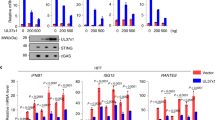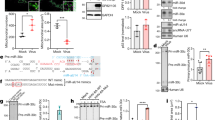Abstract
Although approximately 200 viral microRNAs are known, only very few share similar targets with their host's microRNAs. A notable example of this is the stress-induced ligand MICB, which is targeted by several distinct viral and cellular microRNAs. Through the investigation of the microRNA-mediated immune-evasion strategies of herpesviruses, we initially identified two new cellular microRNAs that targeted MICB and were expressed differently both in healthy tissues and during melanocyte transformation. We show that coexpression of various pairs of cellular microRNAs interfered with the downregulation of MICB, whereas the viral microRNAs optimized their targeting ability to efficiently downregulate MICB. Moreover, we demonstrate that through site proximity and possibly inhibition of translation, a human cytomegalovirus (HCMV) microRNA acts synergistically with a cellular microRNA to suppress MICB expression during HCMV infection.
This is a preview of subscription content, access via your institution
Access options
Subscribe to this journal
Receive 12 print issues and online access
$209.00 per year
only $17.42 per issue
Buy this article
- Purchase on Springer Link
- Instant access to full article PDF
Prices may be subject to local taxes which are calculated during checkout







Similar content being viewed by others
References
Guerra, N. et al. NKG2D-deficient mice are defective in tumor surveillance in models of spontaneous malignancy. Immunity 28, 571–580 (2008).
Lakshmikanth, T. et al. NCRs and DNAM-1 mediate NK cell recognition and lysis of human and mouse melanoma cell lines in vitro and in vivo. J. Clin. Invest. 119, 1251–1263 (2009).
Arnon, T.I., Markel, G. & Mandelboim, O. Tumor and viral recognition by natural killer cells receptors. Semin. Cancer Biol. 16, 348–358 (2006).
Eagle, R.A. & Trowsdale, J. Promiscuity and the single receptor: NKG2D. Nat. Rev. Immunol. 7, 737–744 (2007).
Gasser, S., Orsulic, S., Brown, E.J. & Raulet, D.H. The DNA damage pathway regulates innate immune system ligands of the NKG2D receptor. Nature 436, 1186–1190 (2005).
Gasser, S. & Raulet, D.H. Activation and self-tolerance of natural killer cells. Immunol. Rev. 214, 130–142 (2006).
Gonzalez, S., Groh, V. & Spies, T. Immunobiology of human NKG2D and its ligands. Curr. Top. Microbiol. Immunol. 298, 121–138 (2006).
Groh, V. et al. Cell stress-regulated human major histocompatibility complex class I gene expressed in gastrointestinal epithelium. Proc. Natl. Acad. Sci. USA 93, 12445–12450 (1996).
Groh, V., Steinle, A., Bauer, S. & Spies, T. Recognition of stress-induced MHC molecules by intestinal epithelial gammadelta T cells. Science 279, 1737–1740 (1998).
Venkataraman, G.M., Suciu, D., Groh, V., Boss, J.M. & Spies, T. Promoter region architecture and transcriptional regulation of the genes for the MHC class I-related chain A and B ligands of NKG2D. J. Immunol. 178, 961–969 (2007).
Nachmani, D., Stern-Ginossar, N., Sarid, R. & Mandelboim, O. Diverse herpesvirus microRNAs target the stress-induced immune ligand MICB to escape recognition by natural killer cells. Cell Host Microbe 5, 376–385 (2009).
Doubrovina, E.S. et al. Evasion from NK cell immunity by MHC class I chain-related molecules expressing colon adenocarcinoma. J. Immunol. 171, 6891–6899 (2003).
Dranoff, G. Targets of protective tumor immunity. Ann. NY Acad. Sci. 1174, 74–80 (2009).
Groh, V., Wu, J., Yee, C. & Spies, T. Tumour-derived soluble MIC ligands impair expression of NKG2D and T-cell activation. Nature 419, 734–738 (2002).
Stern-Ginossar, N. et al. Host immune system gene targeting by a viral miRNA. Science 317, 376–381 (2007).
Wilkinson, G.W. et al. Modulation of natural killer cells by human cytomegalovirus. J. Clin. Virol. 41, 206–212 (2008).
Ambros, V. The functions of animal microRNAs. Nature 431, 350–355 (2004).
Bartel, D.P. MicroRNAs: genomics, biogenesis, mechanism, and function. Cell 116, 281–297 (2004).
Bartel, D.P. MicroRNAs: target recognition and regulatory functions. Cell 136, 215–233 (2009).
Chekulaeva, M. & Filipowicz, W. Mechanisms of miRNA-mediated post-transcriptional regulation in animal cells. Curr. Opin. Cell Biol. 21, 452–460 (2009).
Du, T. & Zamore, P.D. microPrimer: the biogenesis and function of microRNA. Development 132, 4645–4652 (2005).
Du, T. & Zamore, P.D. Beginning to understand microRNA function. Cell Res. 17, 661–663 (2007).
Baek, D. et al. The impact of microRNAs on protein output. Nature 455, 64–71 (2008).
Selbach, M. et al. Widespread changes in protein synthesis induced by microRNAs. Nature 455, 58–63 (2008).
Carrington, J.C. & Ambros, V. Role of microRNAs in plant and animal development. Science 301, 336–338 (2003).
Davidson-Moncada, J., Papavasiliou, F.N. & Tam, W. MicroRNAs of the immune system: roles in inflammation and cancer. Ann. NY Acad. Sci. 1183, 183–194 (2010).
Garzon, R., Calin, G.A. & Croce, C.M. MicroRNAs in cancer. Annu. Rev. Med. 60, 167–179 (2009).
Yekta, S., Tabin, C.J. & Bartel, D.P. MicroRNAs in the Hox network: an apparent link to posterior prevalence. Nat. Rev. Genet. 9, 789–796 (2008).
Stern-Ginossar, N. et al. Human microRNAs regulate stress-induced immune responses mediated by the receptor NKG2D. Nat. Immunol. 9, 1065–1073 (2008).
Jonjić, S., Babić, M., Polić, B. & Krmpotić, A. Immune evasion of natural killer cells by viruses. Curr. Opin. Immunol. 20, 30–38 (2008).
Powers, C., DeFilippis, V., Malouli, D. & Fruh, K. Cytomegalovirus immune evasion. Curr. Top. Microbiol. Immunol. 325, 333–359 (2008).
Boss, I.W., Plaisance, K.B. & Renne, R. Role of virus-encoded microRNAs in herpesvirus biology. Trends Microbiol. 17, 544–553 (2009).
Friedman, R.C., Farh, K.K., Burge, C.B. & Bartel, D.P. Most mammalian mRNAs are conserved targets of microRNAs. Genome Res. 19, 92–105 (2009).
Choy, M.K. & Phipps, M.E. MICA polymorphism: biology and importance in immunity and disease. Trends Mol. Med. 16, 97–106 (2010).
Stern-Ginossar, N. & Mandelboim, O. An integrated view of the regulation of NKG2D ligands. Immunology 128, 1–6 (2009).
Ebert, M.S., Neilson, J.R. & Sharp, P.A. MicroRNA sponges: competitive inhibitors of small RNAs in mammalian cells. Nat. Methods 4, 721–726 (2007).
Grimson, A. et al. MicroRNA targeting specificity in mammals: determinants beyond seed pairing. Mol. Cell 27, 91–105 (2007).
Saetrom, P. et al. Distance constraints between microRNA target sites dictate efficacy and cooperativity. Nucleic Acids Res. 35, 2333–2342 (2007).
Grey, F. et al. Identification and characterization of human cytomegalovirus-encoded microRNAs. J. Virol. 79, 12095–12099 (2005).
Eissmann, P. et al. Multiple mechanisms downstream of TLR-4 stimulation allow expression of NKG2D ligands to facilitate macrophage/NK cell crosstalk. J. Immunol. 184, 6901–6909 (2010).
Yadav, D., Ngolab, J., Lim, R.S., Krishnamurthy, S. & Bui, J.D. Cutting edge: down-regulation of MHC class I-related chain A on tumor cells by IFN-γ-induced microRNA. J. Immunol. 182, 39–43 (2009).
Gottwein, E. et al. A viral microRNA functions as an orthologue of cellular miR-155. Nature 450, 1096–1099 (2007).
Skalsky, R.L. et al. Kaposi's sarcoma-associated herpesvirus encodes an ortholog of miR-155. J. Virol. 81, 12836–12845 (2007).
Lu, F. et al. Epstein-Barr virus-induced miR-155 attenuates NF-κB signaling and stabilizes latent virus persistence. J. Virol. 82, 10436–10443 (2008).
Grey, F., Meyers, H., White, E.A., Spector, D.H. & Nelson, J. A human cytomegalovirus-encoded microRNA regulates expression of multiple viral genes involved in replication. PLoS Pathog. 3, e163 (2007).
Stern-Ginossar, N. et al. Analysis of human cytomegalovirus-encoded microRNA activity during infection. J. Virol. 83, 10684–10693 (2009).
Mandelboim, O. et al. Protection from lysis by natural killer cells of group 1 and 2 specificity is mediated by residue 80 in human histocompatibility leukocyte antigen C alleles and also occurs with empty major histocompatibility complex molecules. J. Exp. Med. 184, 913–922 (1996).
Acknowledgements
We thank A. Bernard (Hôpital de l'Archet, Nice, France) for monoclonal anti-CD99 (12E7); Y. Livneh, D. Davis and S. Jonjic and all members of the Mandelboim laboratory for suggestions and discussions and for critical reading of the manuscript; S. Diederichs and W. Filipowicz for discussions and suggestions; and M. Lotem and team (Hadassah Hospital) for primary melanocytes and nevi. Supported by the Israeli Science Foundation (O.M.), The Israeli Science Foundation (Morasha, to O.M.), Croatia-Israel Research (O.M.), Ministry of Science and Technology–Deutsches Krebsforschungszentrum (O.M.), The European Consortium (MRTN-CT-2005 to O.M.), Rosetrees Trust (O.M.), the Israel Cancer Association (20100003 to O.M.) and the Association for International Cancer Research (O.M.).
Author information
Authors and Affiliations
Contributions
D.N. did all experiments, analyzed the data and wrote the paper; D.L. and D.G.W. provided reagents; and O.M. supervised the project.
Corresponding author
Ethics declarations
Competing interests
The authors declare no competing financial interests.
Supplementary information
Supplementary Text and Figures
Supplementary Figures 1–8, Supplementary Tables 1–2 and Supplementary Methods (PDF 388 kb)
Rights and permissions
About this article
Cite this article
Nachmani, D., Lankry, D., Wolf, D. et al. The human cytomegalovirus microRNA miR-UL112 acts synergistically with a cellular microRNA to escape immune elimination. Nat Immunol 11, 806–813 (2010). https://doi.org/10.1038/ni.1916
Received:
Accepted:
Published:
Issue Date:
DOI: https://doi.org/10.1038/ni.1916
This article is cited by
-
MicroRNAs expressed by human cytomegalovirus
Virology Journal (2020)
-
Altered human cytomegalovirus-encoded miRNAs in host circulation: novel disease biomarkers and potential aetiological agents
ExRNA (2019)
-
Profiling of microRNAs modulating cytomegalovirus infection in astrocytoma patients
Neurological Sciences (2018)
-
Human cytomegalovirus-encoded miR-UL112 contributes to HCMV-mediated vascular diseases by inducing vascular endothelial cell dysfunction
Virus Genes (2018)
-
HSV-1-encoded microRNA miR-H1 targets Ubr1 to promote accumulation of neurodegeneration-associated protein
Virus Genes (2018)



